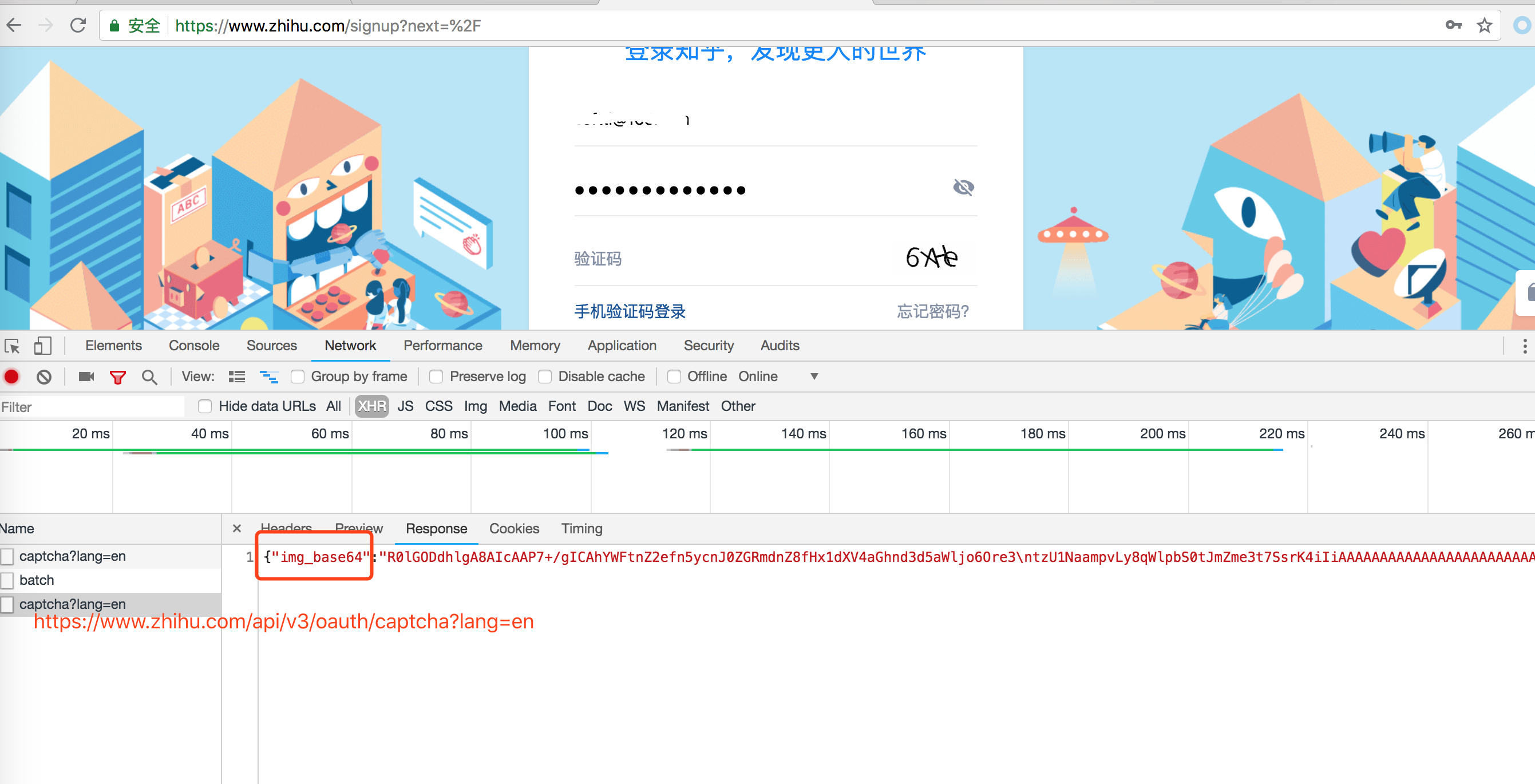前面了解了scrapy框架的大概各个组件的作用,
现在要爬取知乎数据,那么第一步就是要登录!
看下知乎的登录页面发现登录主要是两大接口
一: 登录页面地址,获取登录需要的验证码,如下图
打开知乎登录页面,需要输入用户名和密码, 还有一个验证码,
看chrome 调试工具发现验证码是这个地址返回的: https://www.zhihu.com/api/v3/oauth/captcha?lang=en
返回的结果中用base64加密了, 我们需要手动解密

二: 知乎登录接口
登录接口就是点击登录按钮访问的接口,
接口地址: https://www.zhihu.com/api/v3/oauth/sign_in
我们要做的就是封装参数,调用登录接口.

代码如下:
# -*- coding: utf-8 -*- import hmacimport jsonimport scrapyimport timeimport base64from hashlib import sha1 class ZhihuLoginSpider(scrapy.Spider): name = 'zhihu_login' allowed_domains = ['www.zhihu.com'] start_urls = ['http://www.zhihu.com/'] agent = 'Mozilla/5.0 (Windows NT 10.0; Win64; x64) AppleWebKit/537.36 (KHTML, like Gecko) Chrome/65.0.3325.181 Safari/537.36' # agent = 'Mozilla/5.0 (Windows NT 6.2; WOW64) AppleWebKit/537.36 (KHTML, like Gecko) Chrome/27.0.1453.94 Safari/537.36' headers = { 'Connection': 'keep-alive', 'Host': 'www.zhihu.com', 'Referer': 'https://www.zhihu.com/signup?next=%2F', 'User-Agent': agent, 'authorization': 'oauth c3cef7c66a1843f8b3a9e6a1e3160e20' } grant_type = 'password' client_id = 'c3cef7c66a1843f8b3a9e6a1e3160e20' source = 'com.zhihu.web' timestamp = str(int(time.time() * 1000)) timestamp2 = str(time.time() * 1000) print(timestamp) print(timestamp2) # 验证登录成功之后, 可以开始真正的爬取业务 def check_login(self, response): # 验证是否登录成功 text_json = json.loads(response.text) print(text_json) yield scrapy.Request('https://www.zhihu.com/inbox', headers=self.headers) def get_signature(self, grant_type, client_id, source, timestamp): """处理签名""" hm = hmac.new(b'd1b964811afb40118a12068ff74a12f4', None, sha1) hm.update(str.encode(grant_type)) hm.update(str.encode(client_id)) hm.update(str.encode(source)) hm.update(str.encode(timestamp)) return str(hm.hexdigest()) def parse(self, response): print("****************") print(response.url) #print(response.body.decode("utf-8")) def start_requests(self): yield scrapy.Request('https://www.zhihu.com/api/v3/oauth/captcha?lang=en', headers=self.headers, callback=self.is_need_capture) def is_need_capture(self, response): print(response.text) need_cap = json.loads(response.body)['show_captcha'] print(need_cap) if need_cap: print('需要验证码') yield scrapy.Request( url='https://www.zhihu.com/api/v3/oauth/captcha?lang=en', headers=self.headers, callback=self.capture, method='PUT' ) else: print('不需要验证码') post_url = 'https://www.zhihu.com/api/v3/oauth/sign_in' post_data = { "client_id": self.client_id, "username": "", # 输入知乎用户名 "password": "", # 输入知乎密码 "grant_type": self.grant_type, "source": self.source, "timestamp": self.timestamp, "signature": self.get_signature(self.grant_type, self.client_id, self.source, self.timestamp), # 获取签名 "lang": "en", "ref_source": "homepage", "captcha": '', "utm_source": "baidu" } yield scrapy.FormRequest( url=post_url, formdata=post_data, headers=self.headers, callback=self.check_login ) # yield scrapy.Request('https://www.zhihu.com/captcha.gif?r=%d&type=login' % (time.time() * 1000), # headers=self.headers, callback=self.capture, meta={"resp": response}) # yield scrapy.Request('https://www.zhihu.com/api/v3/oauth/captcha?lang=en', # headers=self.headers, callback=self.capture, meta={"resp": response},dont_filter=True) def capture(self, response): # print(response.body) try: img = json.loads(response.body)['img_base64'] except ValueError: print('获取img_base64的值失败!') else: img = img.encode('utf8') img_data = base64.b64decode(img) with open('/var/www/html/scrapy/zh.gif', 'wb') as f: f.write(img_data) f.close() captcha = raw_input('请输入验证码:') post_data = { 'input_text': captcha } yield scrapy.FormRequest( url='https://www.zhihu.com/api/v3/oauth/captcha?lang=en', formdata=post_data, callback=self.captcha_login, headers=self.headers ) def captcha_login(self, response): try: cap_result = json.loads(response.body)['success'] print(cap_result) except ValueError: print('关于验证码的POST请求响应失败!') else: if cap_result: print('验证成功!') post_url = 'https://www.zhihu.com/api/v3/oauth/sign_in' post_data = { "client_id": self.client_id, "username": "", # 输入知乎用户名 "password": "", # 输入知乎密码 "grant_type": self.grant_type, "source": self.source, "timestamp": self.timestamp, "signature": self.get_signature(self.grant_type, self.client_id, self.source, self.timestamp), # 获取签名 "lang": "en", "ref_source": "homepage", "captcha": '', "utm_source": "" } headers = self.headers headers.update({ 'Origin': 'https://www.zhihu.com', 'Pragma': 'no - cache', 'Cache-Control': 'no - cache' }) yield scrapy.FormRequest( url=post_url, formdata=post_data, headers=headers, callback=self.check_login ) |
登录成功后调用check_login方法测试是否有登录状态.
我在后面爬取 知乎问题和答案的时候把这个方法当做start_requests方法,用来构造爬取地址.
原文出处:https://www.cnblogs.com/wangtcc/p/9620016.html
点击查看更多内容
为 TA 点赞
3 评论
共同学习,写下你的评论
Dandelion_Yang
写的非常好,帮我把promise理解了
慕村5492868
image.onoad>>image.onload?
作者其他优质文章
正在加载中
感谢您的支持,我会继续努力的~
扫码打赏,你说多少就多少
赞赏金额会直接到老师账户
支付方式
打开微信扫一扫,即可进行扫码打赏哦







function loadImageAsync (url) { return new Promise( function( resolve, reject){ var image = new Image(); image .onoad = function(){ resolve(image); }; image.onerror = function () { reject(new Error("could not load image at "+ url) ); }; image.src =url; });}loadImageAsync(url).then( function (value) { console.log(value);})